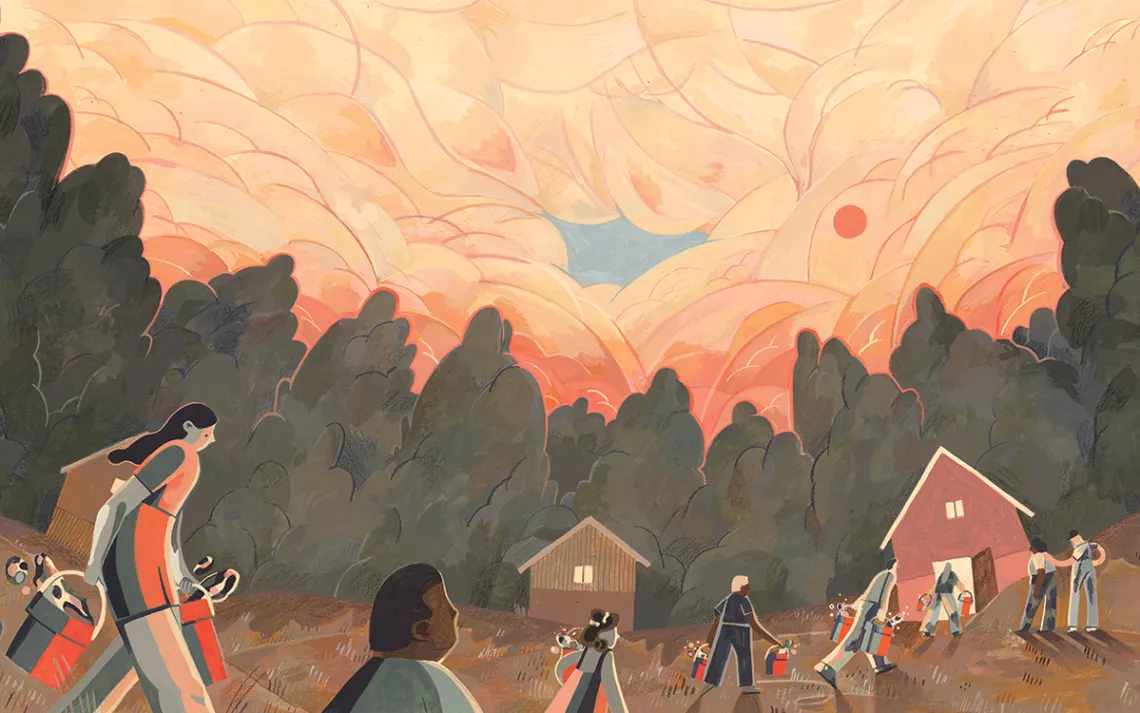Climate Chaos and Fire Bring an Oregon Community Together
Greensprings, Oregon, has always been tight-knit. Adversity has made it more so.

Illustration by Tilda Rose
When I moved to Oregon in 2000, wildfire season meant a few smoky days in August and learning the names of big fires burning on public lands far away. These days, when the smoke arrives, a now-familiar dread lodges in my gut.
My husband and I live in the Greensprings, a mountain community east of Ashland. We're volunteer firefighters, and in recent years wildfire season has consumed our summers. We monitor every lightning strike, every fire burning nearby, every white fir dying on our property. We don't leave the mountain on red-flag days. We know what could happen.
In September 2020, the Almeda Fire ripped through the Rogue Valley. Our tiny firefighting agency joined in the endeavor to contain the fire and save what homes we could. Despite firefighters' efforts, the blaze destroyed entire sections of the towns of Talent and Phoenix. Thousands of people were displaced; nearly a third of the families in the school district lost their homes. Since then, several longtime friends have sold their houses, joining a seeming exodus out of the region.
After Almeda, we in the Greensprings took solace that our community, though frayed, was still intact. But with the drought unrelenting, last summer threatened to be even worse than the summer before. By June, the forest litter crackled like cornflakes. Megafires flared to our east and south. The smoke rolled in. My eyes watered, and my nose ran. I felt stunned into lethargy under the burnt-umber pall. In mid-August, we started counting down the days. Another month and we could exhale.
We thought fire was our biggest threat. Then, one day in late August, I turned on the faucet and nothing came out. I turned it off, then on again, disbelieving. The drought had come home: Our well had run dry.
Our well technician recommended lowering our pump and installing a storage tank—the bigger, the better. We hired our neighbor Jesse to dig a trench for the new plumbing. The trench gaped across our driveway like a ripped seam while we waited to drop the pump. We drank out of jugs and tried not to panic.
I looked up the well log for our neighborhood. The map showed blue circles superimposed on every five- and 10-acre lot. Most of these straws were stuck in the aquifer within the past 40 years. But patterns have changed. Old-timers describe snow that piled to the eaves. No more.
Can we keep living here? Should we? It felt like we were pushing against the edge of something.
Then one neighbor offered to run hoses from their garden to ours. Another told us to use their shower and laundry: "You don't have to ask. Just come over."
We let ourselves be helped, and to be held. It made all the difference to not feel alone in this crisis.
Later that week, our fire department responded to a house fire near one of the local reservoirs. During a run to fill our water tanker, we drove far out onto the lake bed to reach the stagnant water pooled next to the dam. While the pump sucked water out of the sad little pond, I gazed at the curve of the shrunken shoreline, at the bleached tree snags poking the orange sky. A dead white pelican lay folded against itself near the shore, feathers caked with ochre-colored dust.
The house burned, but we contained the fire. It took hours to completely cool the scene. Someone brought us sandwiches. Jesse, who had shown up to help with the fire, let me drive his truck home. Later, he would come by to fill in the trench. As I made the familiar turn at the Green Springs Inn, I felt the steering wheel's shredded fabric under my hands, and for a moment, dread gave way to gratitude.
This article appeared in the Spring 2022 quarterly edition with the headline "Misery and Company."
 The Magazine of The Sierra Club
The Magazine of The Sierra Club



